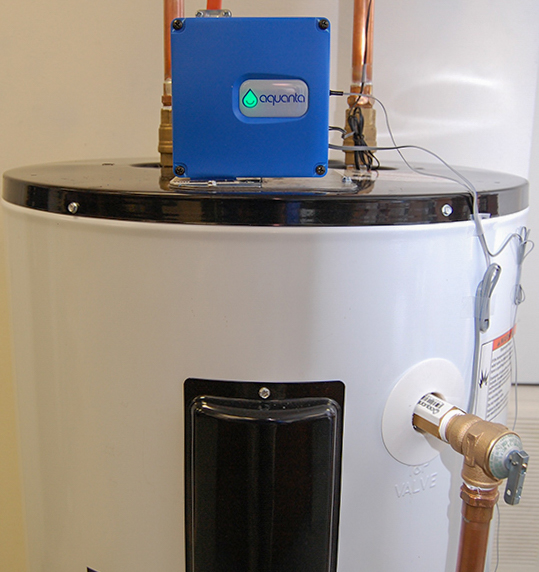
Image Credit: Aquanta
On the heels of offering customers a deal on Tesla Powerwall 2 batteries and deep discounts on Leaf electric vehicles, Green Mountain Power is rolling out a new plan aimed at saving customers money and reducing loads on the grid.
Green Mountain, a B Certified Corporation and Vermont’s largest electric utility, launched its “eSmartwater Program” late last month, announcing it would provide an Aquanta water heater controller and a Nest Learning Thermostat for 99 cents a month.
Green Mountain customers should see a nice return on their buck. The third-generation Nest, which goes for $249 at the company website, is designed to teach itself when to raise and lower indoor temperatures based on family habits. The $149 Aquanta also is designed to save money by adjusting water temperates to meet a family’s needs via an “autonomous learning function.” Both WiFi-connected devices can be controlled with a smartphone.
Green Mountain predicted that customers would be able to save an average of $131 to $145 a year with the Nest; Aquanta says customers should be able to trim between 10% and 30% from their water heating bills.
As a post at GTM explained, customers who take the 99-cent deal also agree to give Green Mountain some control over their water heaters, within certain limits. “We can basically push a button, schedule water heaters to turn off at this time,” and use the resulting load drop to reduce system-wide capacity charges, or mitigate congestion on distribution circuits, Josh Castonguay, GMP’s director of generation and renewable innovation, told GTM.
Weekly Newsletter
Get building science and energy efficiency advice, plus special offers, in your inbox.














2 Comments
10 to 30% DHW savings how?
I'm all for selling the right to control my water heater to the utility, and I guess the contract in this case is giving the consumer a fun toy as compensation. But they are also selling it as "saves 10 to 30%". If you start with a 0.95 EF electric tank water heater, there's only 5% available to save, if your usage matches the standard usage that rating is based on.
Response to Charlie Sullivan
Charlie,
I agree with you that 30% seems impossible to me, but I disagree with your use of the EF number to put a cap on possible savings.
The EF test is based on draws of 64 gallons per day, which is unreasonably high (as many researchers have shown). Most families use 40 to 45 gallons per day.
Actual electricity use depends not only on the EF of the unit, but also on usage patterns. To take an extreme example: what if a family takes a three-week vacation? Family A turns off their water heater; Family B leaves it set to 140 degrees. Obviously, Family A will save a significant amount of electricity that month compared to Family B -- and the savings will be much more than 5%.
If the smart controller could anticipate a vacation departure time and return time, imagine the savings! The controller isn't quite that smart, but you can see where my reasoning is leading.
If a controller notices that the occupants of the home have a single draw of hot water each day, and that draw always occurs between 7:00 a.m. and 7:30 p.m., savings could be achieved by turning the water heater off for 21 hours a day (from 7:45 a.m. to 4:45 a.m.). I doubt if any controller would be programmed to use that approach, but it's an example of theoretical savings.
Log in or create an account to post a comment.
Sign up Log in